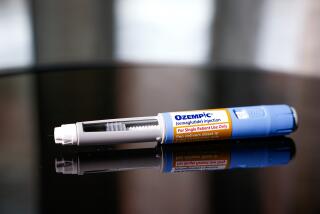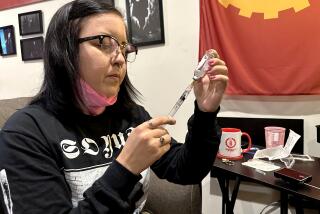Insulin Pump Brings New Independence to Diabetics : The device may be small in size, yet it is dramatic in what it has given to its users--more responsibility and control in their own health care.
- Share via
A year and a half ago, diabetic Cyndie Flores of Garden Grove was losing ground fast, and she knew it.
The red blood vessels in her eyes “looked like they were going to rupture,” a warning sign of diabetic retinopathy, the leading cause of blindness in people ages 20 to 74. Her feet tingled with the sensation of pins and needles, a signal that nerve damage was beginning to take place in her extremities.
After 14 years with the disease, she was up to four insulin injections a day, and although she followed her doctor’s instructions as conscientiously as possible, her blood sugar levels were still on a roller coaster.
That terrifying ride is over now, thanks to the insulin pump, a small device about the size of a pager that is tethered to her body with a 40-inch-long tube. Twenty-four hours a day, the device pumps a slow, steady dose of insulin into her bloodstream to replace that which her malfunctioning pancreas no longer produces. When she’s about to eat, she adjusts the controls to increase the insulin flow, and just before exercise she turns it down.
Her eyes have returned to normal now, and the tingling in her feet has subsided.
“I feel really healthy now,” she said. “It’s not what I expected at all. I was really negative about getting a pump. It just seemed like a last resort. But really, it’s something any diabetic who’s on insulin can benefit from.
“Now I don’t have to feel like I’m a sick diabetic. I’m just like everybody else, except I wear my pancreas on the outside of my body.”
The insulin pump is the most dramatic of the new technologies that have allowed diabetics to take more and more responsibility for their own health in recent years. Those changes, combined with new health insurance rules aimed at reserving hospitalization for only the most seriously ill, have revolutionized care for diabetics, said Steven Saltman, a Fullerton endocrinologist.
Outside the hospitals and doctor’s offices, diabetics are now more independent than ever, using machines at home to test their own blood sugar levels, working as fully participating partners in their own care.
“It’s much more of a working relationship now,” Saltman said. “They can help us help them.”
In the hospital, meanwhile, diabetics are now rarely even admitted for the disease itself.
“Very few people are coming into the emergency room with their diabetes out of control,” he said. “And because of insurance, we can hardly even admit them for insulin therapy. So instead, the diabetics we see in the hospital have other primary diagnoses, such as heart disease or infections. But their diabetes still needs to be considered.”
That’s why Saltman and other endocrinologists worked with St. Jude Hospital and Rehabilitation Center in Fullerton to establish the hospital’s Diabetes Life Center, the only program in Orange County to be certified by the American Diabetes Assn. The center features not only a 10-bed inpatient unit for diabetics hospitalized for various causes, but also an outpatient program with psychologists, pharmacists, physical therapists and dietitians to help diabetics deal with all aspects of life.
“Diabetes affects every aspect of life, and it requires a tremendous amount of work just to understand it,” Saltman said. “Patients need continual education, because it really is up to them.”
Diabetes still claims lives, more than 150,000 a year nationwide, and is the third-leading cause of death from disease in the nation. Those most at risk for complications that could lead to death are the diabetics who don’t take an active role in their own care, Saltman said.
“The ones who bury their heads in the sand are the ones who are going to have trouble,” he said.
It’s especially difficult to take responsibility for diabetes if you don’t even know you have it. But half the 14 million Americans who have the disease don’t even know it. In Orange County, the local chapter of the American Diabetes Assn. estimates that’s also true for the estimated 125,000 diabetics who live here.
For Flores, 30, the disease came on suddenly when she was 16 years old. She got sick, went to the hospital and was diagnosed. But for Julia Welch of Placentia, the onset was less dramatic.
Now 68, Welch was 56 when a routine physical told her doctors there was a problem. Until then, she had no symptoms other than fatigue. Welch received her insulin pump in 1986.
In Orange County, the American Diabetes Assn. is redoubling its efforts to reach Latinos, who for some unknown reason have a more than 300% greater chance of developing diabetes. During November, National Diabetes Month, the association is distributing its new Spanish-language brochures on diabetes.
For information on screenings and other events during National Diabetes Month, call the chapter office at (714) 662-7940.
Some of the Warning Signs of 2 Major Types of Diabetes
Half of the estimated 125,000 Orange Countians who have diabetes don’t even know it, according to the local chapter of the American Diabetes Assn. The disease is a malfunction of the pancreas, making the body unable to produce or respond to insulin, a hormone that changes food to the sugar the body uses for energy.
Those most at risk for diabetes include people who are over 30, who have a family history of diabetes, who are overweight or are of Latino, African American or American Indian descent.
There are two major types of diabetes:
Type I, in which the body does not produce any insulin, usually occurs in children, adolescents and young adults, although it can strike at any age. The other form, Type II, is a metabolic disorder that leaves the body unable to produce enough or properly use insulin.
The symptoms of Type I diabetes include:
* Frequent urination
* Unusual thirst
* Extreme hunger
* Unusual weight loss
* Extreme fatigue
* Irritability
The symptoms of Type II diabetes include all the Type I symptoms, as well as:
* Frequent infections
* Blurred vision
* Cuts and bruises that are slow to heal
* Tingling or numbness in the legs or feet.
For more information, contact the Orange County chapter of the American Diabetes Assn. at (714) 662-7940.
More to Read
Sign up for Essential California
The most important California stories and recommendations in your inbox every morning.
You may occasionally receive promotional content from the Los Angeles Times.










